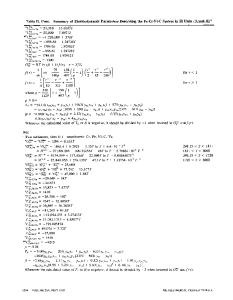A Thermodynamic analysis of the Fe-Cr-N system
- PDF / 748,735 Bytes
- 8 Pages / 594 x 774 pts Page_size
- 113 Downloads / 342 Views
I.
INTRODUCTION
BECAUSEof the technical importance of nitrogen in stainless steels, there have been several recent investigations of the phase relations in the Fe-Cr-N system. Some information on this system can be obtained from the series of investigations by Tisinai et al. ~.2,3who studied the Fe-Cr-C-N and Fe-Cr-Ni-N systems in the composition range 21 to 33 wt pct Cr but also with substantial amounts of silicon and manganese present, using a metallographic technique. More recently, Turkdogan and Ignatowicz 4'5 studied the phase boundaries between austenite and ferrite in the Fe-Cr-N system in the composition range 4 to 30 wt pct Cr by equilibrating Fe-Cr turnings or wires in ammonia or nitrogen at certain nitrogen partial pressures and at different temperatures. Okamoto and Naito 6 studied phase equilibria involving the liquid phase in the composition range 12 to 60 wt pct Cr using thermal analysis and metallographic methods. Mortimer 7 studied precipitation of nitrides in alloys with 0 to 40 wt pct Cr by electron microscopy and Imai, Masumoto, and Maeda 8'9 studied equilibria involving nitrides in the range 0 to 40 wt pct chromium and up to 1 wt pct nitrogen using optical and electron microscopy and constructed isothermal sections of the Fe-Cr-N system from 973 to 1573 K (700 to 1300 ~ The purpose of the present work was to analyze the available information on the Fe-Cr-N system by the use of thermodynamic models for the individual phases and to synthesize the phase diagram by calculation. For the evaluation of thermodynamic parameters in higher-order systems than binaries it is essential to have information on the slopes of tie lines. Unfortunately, the available phase equilibrium information concerns the position of phase boundaries only. An experimental study of tie lines was thus included in the present work. In order to make the new information on the tie lines as powerful as possible the nitrogen activity was measured for each tie line studied. Furthermore, some of the previous studies ~'2'3 were made with considerable amounts of impurities. New experiments with higher purity materials were thus desirable. The analysis of the Fe-Cr-N system is based upon similar analyses of the three binary systems Fe-N,l~ Cr-N,ll and Fe-Cr. 12
STAFFAN HERTZMAN, formerly with Royal Institute of Technology, Stockholm, is with Swedish Institute for Metals Research, Drottning Kristinas V]ig 48, S-114 28 Stockholm, Sweden. MAGNUS JARL is with MEFOS, Metal Working Research Plant, LuleL Sweden. Manuscript submitted January 18, 1985.
METALLURGICAL TRANSACTIONS A
II.
EXPERIMENTAL
The experimental measurements reported in this work were carried out in order to clarify the phase relations in critical portions of the phase diagram. Microprobe measurements were employed in order to obtain direct information on the tie lines between phases in equilibrium, as opposed to metallographic experiments which give only the positions of phase boundaries. In order to obtain additional information on the nitrogen activity for a tie line
Data Loading...











